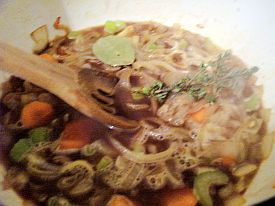After seasoning the meat, the next step is to chop up some vegetables, then saute them in a bit of butter for awhile, first the onions, then the celery and carrots. Next you add and briefly saute some garlic, then tomato paste, some beef broth, a bit of red wine and a sprig of thyme and a bay leaf.
Once that's simmering, you add the roast, cover the pot tightly with foil before putting the lid on, then toss it into the oven, preheated to 300 degrees. The roast then cooks for a few hours. After letting the roast cool for a bit, I took out the bay leaf and thyme sprig and transferred the roast, vegetables and liquid to a covered dish before putting it into the fridge overnight.
The next day, I removed the roast from the pan and sliced it up, tossed it in a casserole dish, covered the dish with foil and tossed it in the oven for a bit to reheat the roast. Meanwhile, I skimmed off the (now solidified) fat from the liquid, then poured the liquid and the well-cooked vegetables into the blender. After pureeing the vegetable-liquid mix, I tossed in a bit more red wine and cooked the puree on the stovetop, seasoning it and cooking until it thickened. By the time that was done, the roast was warmed up, so I transferred it to a serving platter and ladled some of the gravy over it.
Since I knew I was going to be making gravy, it seemed just natural to make some mashed potatoes to go with that. And since the roast was (at least according to the people who'd written up the recipe and accompanying article for Cook's Illustrated
Everything turned out great. The roast beef was not just "really good." It was tender and incredibly flavorful, and easily the best roast beef I've ever made, or had. The gravy went well with both the beef and the potatoes, and the potatoes were quite tasty, the cheese flavor and the tang of a bit of buttermilk allowing them to hold their own with the savory gravy. The squash turned out pretty good, too, but I'll cover that in another post.
The pot roast recipe is a real winner. Hats off to the fine people at Cook's Illustrated
Parmesan Mashed Potatoes
yield = 4-5 servings
2 pounds potatoes
3 tablespoons butter, softened
1/2 cup freshly grated Parmigiano-Reggiano cheese
1/4 cup skim milk
1/4 cup buttermilk
1/2 teaspoon freshly-ground black pepper
1/4 teaspoon salt
Fill a large saucepan or other pan with water to a depth of about 3 inches. Start the water boiling.
Peel the potatoes and quarter them (or halve them, if they are small). Add them to the water when it starts boiling and cook until a fork slides easily in and out of the potato pieces with minimal to no effort. Drain the potatoes, then immediately move them to the bowl of a stand mixer.
Add the butter and Parmigiano-Reggiano and start to mix the potatoes, butter and cheese on low. Gradually add in the milk, salt and pepper and increase speed to medium until the potatoes are fluffed and thoroughly mixed. Serve immediately.
Note:
The recipe will result in potatoes somewhat more stiff than usual for mashed potatoes. This is intentional, as to not overwhelm the flavor of the cheese with too much milk, but feel free to add more milk to your own taste.






Juli here. This recipe is definitely a "5". How can I tell? Well...if I was left alone with the gravy...I would drink it. SO. GOOD!
ReplyDelete